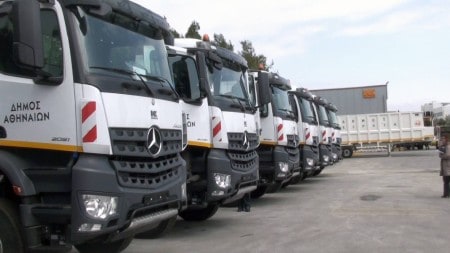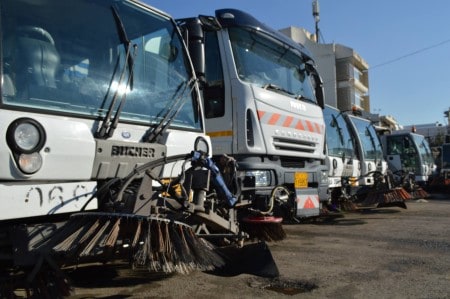From efficient collection techniques to making the collection points a smooth process, the Municipality of Athens has developed productive waste management services across the city.
Timothy Byrne
Athens, the capital of Greece, has a population of 667,000, which doubles in the summer from tourism. Therefore, waste management is a very important task. The municipality provides a waste management system for the city 24/365 to collect the 311,000 tons of waste produced annually. To provide this, the municipality has a fleet of 45 waste collection vehicles driven by 245 drivers.
The vehicles and staff are based at the central depot with offices on Iera Odos Street in the Egaleo district of Athens. This is near all the central road networks aiding an efficient and productive delivery of waste management services across the city.
Waste and Recycling Collection
To provide a sustainable waste collection system, the municipality has two waste collection rounds for non-recyclable waste and two rounds for recyclable waste. These rounds are based on a collection frequency of 167 waste collection programs, so waste may be collected in certain districts in the night, the early morning or mid-morning. In some areas, such as Syntagma Square and Omonia Square, waste is collected three times a day because of the large quantities of waste produced by hotels, restaurants and shops. Waste is also collected in the afternoon from markets held daily across the various districts once they close.
The municipality has provided green colored 1,100 liter containers for the non-recyclable waste fraction, positioned at communal collection points along the street. For the recyclable waste fraction, blue colored 1,100 liter containers are provided for the commingled collection of dry mixed recyclables.
The non-recyclable and recyclable waste fractions are collected using rear loading type waste collection vehicles. The bulk of the waste collection fleet are 16m3 rear loaders fitted with trunnion/bin lifting equipment mounted onto Mercedes Econic 1828 4×2 two axle chassis powered by liquid natural gas. This helps to reduce emissions and the carbon footprint when collecting waste in the center of Athens. The remainder of the fleet are16m3 rear loader equipment complete with trunnion/bin lifting equipment mounted onto a conventional diesel powered Iveco Eurocargo 190EL28 4×2 two axle chassis. These waste collection vehicles also feature a bin washing device in the rear tailgate canopy of the waste collection vehicle to facilitate the washing of the 1100 litre containers once they have been emptied.
The municipality also uses smaller type waste collection vehicles of 7m3 capacity mounted onto Iveco Eurocargo 4×2 two axle chassis. These collect waste from the streets with narrow access or apartment buildings where many cars are double parked thus restricting the access of a larger waste collection vehicle.
The waste collection crew comprises of a driver and two loaders for the larger waste collection vehicles and, in some cases, for the smaller satellite waste collection vehicles, a driver and one loader. The waste collection operatives position the 1,100 liter containers containing either the non-recyclable or recyclable waste fraction at the rear of the waste collection vehicle to be emptied by the vehicles’ lifting equipment. Once the 1,100 liter containers have been emptied by the lifting equipment, the operatives position the container at the communal collection point to be refilled. Any excess waste next to the full 1,100 liter waste collection containers is also cleared, leaving the area clean and tidy.
Collection Points
At night the driver takes the fully loaded waste collection vehicle to either the Mechanical Biological Treatment (MBT) plant at Ano Liosia to the north of Athens or to the Schistou waste transfer station to discharge the vehicle’s load. Both of these facilities are operated by ESDNA, the inter-municipal owned waste management company responsible for treating municipal waste produced by the municipalities across the region of Attica. The Ano Liosia MBT plant is one of the largest in Europe, helping Greece to meet its EU landfill diversion targets, and provides a sustainable waste treatment system for Athens and Attica. The Schistou waste transfer station has a daily processing capacity of 600 tons and the waste delivered to this facility is transported daily by a fleet of ESDNA Scania 8×4 Multilift LHT320.56 hook loaders to the Fyli sanitary landfill site at Ano Liosia or to the MBT plant at Ano Liosia for processing/treatment.
During the day, the waste collection vehicles deliver their waste directly to the Fyli sanitary landfill site at Ano Liosia, also operated by ESDNA and the largest in Greece. This disposes of all municipal waste that cannot be processed in the MBT plant, produced across Athens as well as from the 66 municipalities across Attica. The landfill site complies fully with the requirements of the EU Landfill Directive (1999/31/EC) and flares methane off site and treats leachate on site in its own desalination plant.
The smaller waste collection vehicles of 7m3 capacity mounted onto Iveco Eurocargo 4×2 two axle chassis, which collect waste from narrow access streets, also collect two loads of waste per program. To provide a more logistical solution, once full, these smaller vehicles do not travel to the MBT plant, waste transfer station or sanitary landfill site, but instead return to the main depot and offices in Iera Odos Street in Egaleo. Upon arrival, they discharge their loads into one of four 46m3 rear loading semi-trailers. These are powered by an auxiliary engine so the tractor unit, which hauls the rear loading semi trailer to the MBT plant, waste transfer station or sanitary landfill site can be used on other duties, e.g., taking one of the sister trailers to be emptied. The 46m3 rear loading semi-trailers hold 25 – 27 tons of waste. Once these are fully loaded, an Iveco Trakker two-axle tractor unit hauls the trailer to either the MBT plant at Ano Loisia, or the Schistou waste transfer station to be discharged during the night or to the Fyli sanitary landfill site for discharge in the daytime. The use of these rear-loading semi-trailers enables the smaller type waste collection vehicles of 7m3 capacity to continue their waste collection program and collect their second load of waste without having to travel distance to the waste treatment centres.
The municipality also operates a mobile waste container service for larger waste producers with a variety of waste containers available to suit larger establishments such as hospitals and industry. These containers can be delivered and collected from site using a conventional Scania P94 4×2 two axle skip loader vehicle, a Scania P94 4×2 two axle hook loader vehicle or an Iveco Trakker 6×4 three axle hook loader vehicle.
There is also a facility at Iera Odos – Egaleo for the discharge of bulky waste, e.g., waste furniture, which is collected by smaller sized non-compaction vehicles. The furniture is reloaded at Iera Odos – Egaleo for bulk hauling to the Fyli sanitary landfill site.
In the Future
In conclusion, the municipality provides a sustainable waste management system for Athens, which will be further developed in the near future with the construction of a purpose built waste transfer station, where municipal waste will be discharged by waste collection vehicles and reloaded into top loading 56m3 waste transfer trailers. It will be bulk hauled to the MBT plant at Ano Loisia or to the Fyli sanitary landfill site, thus optimising and achieving higher levels of productivity from the waste collection service as well as reducing damage to the conventional fleet of larger waste collection vehicles from having to drive off road at the landfill site.
Timothy Byrne is a worldwide waste collection and transfer systems consultant and a freelance waste management technical writer based in Birmingham, UK. He has worked in the waste management industry for 20 years. He lives in the UK and has carried out a lot of work and research into waste collection and waste transfer systems in Mediterranean countries. He has also visited New Delhi to carry out research into waste collection and waste transfer systems in India’s capital city. He can be reached at 0044 1384 211001 or 0044 7545 616110 or via e-mail at [email protected].


